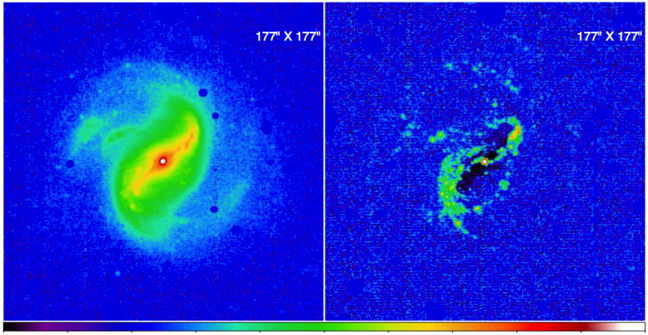
HAGGIS: The H-alpha Galaxy Groups Imaging Survey
PIs: Peter Erwin and David Wilman
Co-Is: Sandesh Kulkarni, John E. Beckman, Leonel Gutierrez, Johannes Koppenhöfer, Roberto Saglia, Ralf Bender
This is an imaging project aimed at understanding how current and recent star formation in the local Universe depends on galaxy environment, particularly in form of groups of different sizes. We are interested in determining where star formation is — and is not — occurring within galaxies, as a function of galaxy mass, morphology, and disk structure, and also as a function of group mass and the location of galaxies within their groups (central vs. satellite, radius from group center, etc.).
The data consist of wide-field imaging, using both the Isaac Newton Telescope's Wide Field Camera and the MPG/ESO 2.2m telescope's Wide Field Imager, in narrow-band filters which match (redshifted) H-alpha and adjacent stellar-continuum regions for galaxies in groups with redshifts of 0.01-0.05. The galaxy groups are taken from the SDSS DR4 catalog of Yang et al. (2007), which provides halo mass estimates for groups ranging from isolated galaxies up through clusters. We have images for over 100 galaxy groups, ranging in size from isolated field galaxies to massive groups just below the regime of true clusters.
The use of narrow-band filters for both H-alpha and continuum imaging, combined with calibration using SDSS fiber spectra, allows us to produce accurate, calibrated H-alpha images which include both emission and, in some cases, absorption.
The reduction and analysis of these data constituted the Ph.D. thesis of MPE graduate student Sandesh Kulkarni; the first papers from this project are currently being written.
Example: HAGGIS Images of 31811-1 (NGC 2718)
These are images of the barred Sa galaxy NGC 2718, obtained with the MPG/ESO 2.2m telescope in January of 2012. This is the most massive galaxy in small, low-mass group (estimated halo mass ~ 8 x 10^12 solar masses).

Left: narrow-band stellar-continuum image (central wavelength ~ 720 nm). Right: continuum-subtracted H-alpha image. Light green, yellow, and red correspond to increasingly strong H-alpha emission; dark blue and black correspond to strong H-alpha absorption. We can see emission from ongoing star formation within and outside the bar, along with strong absorption (dark blue-black in right panel) from recent (< 1–2 Gyr) star formation within the bar.
(Does the name of the project actually have anything to do with Scottish food or possibly mythical Scottish animals? Sadly, no; we just liked the name, and the fact that — unusual though it may be for an astronomical acronym — it actually makes sense and doesn't rely on capitalizing random sets of letters…)